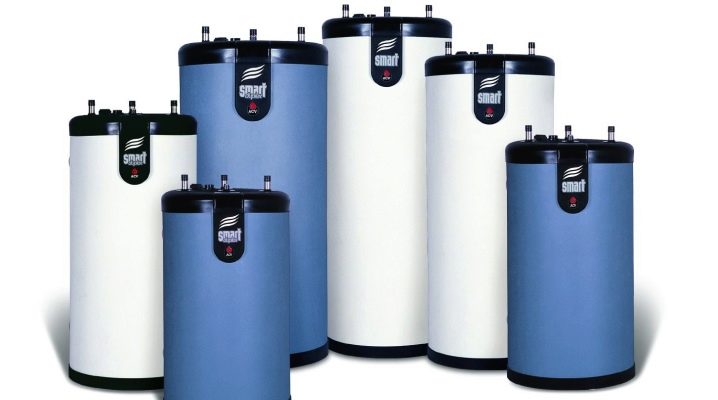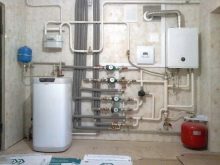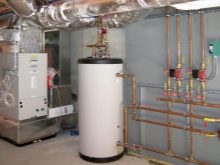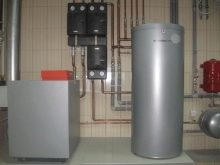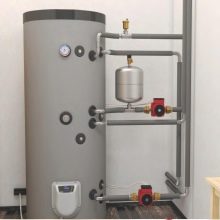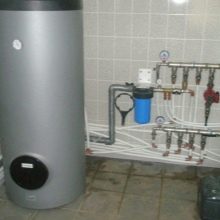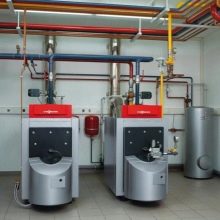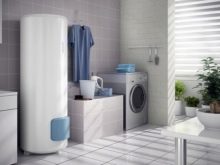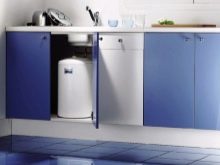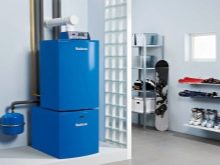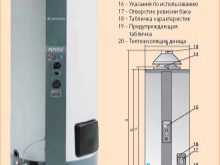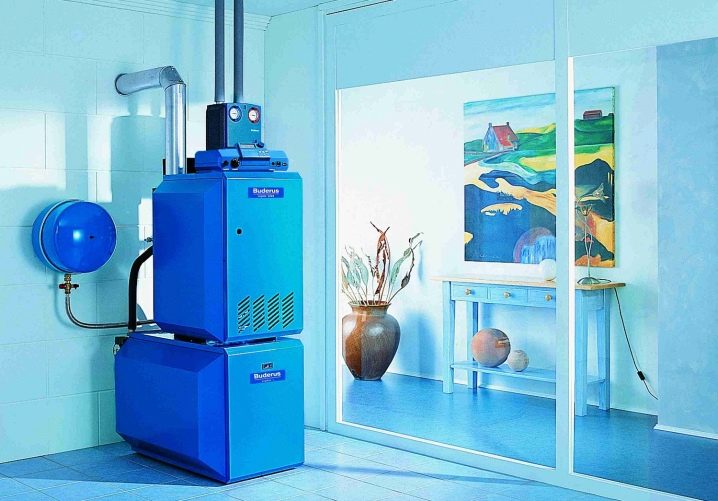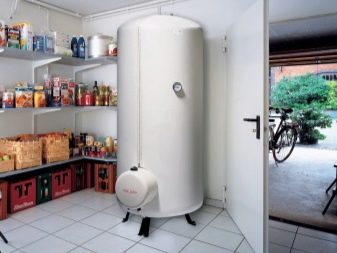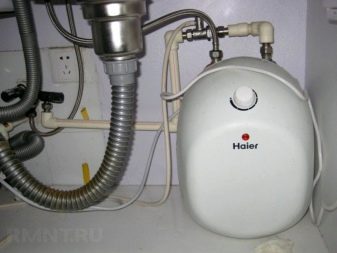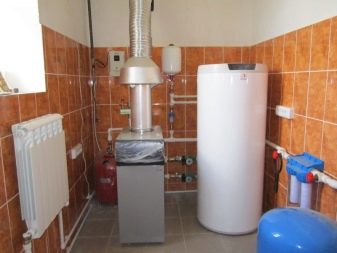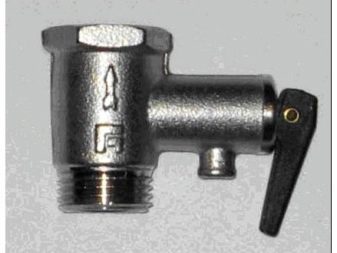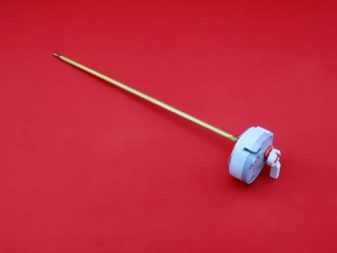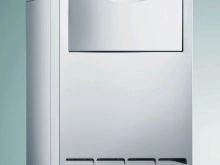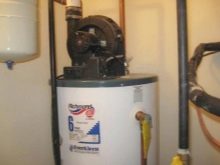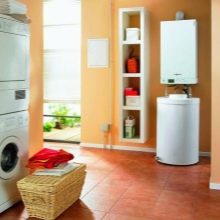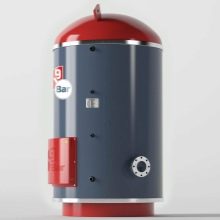Varieties of designs of outdoor water heaters
In many cases, water heating in a centralized way and connection to it is impossible. The solution to this problem can be the choice of a suitable model of the heater. But not always wall hanging versions are quite effective. In this case, you need to consider all existing options to select the best. Often the best view is the outdoor unit.
Special features
The outdoor water heater will harmoniously stand where it is impossible for some reason to install a wall heater. The case may be associated not only with the lack of sufficient space, but also with the special design of the walls themselves, which are not able to withstand the load from hundreds of liters of water. Moreover, there are regular situations when another way to warm the water, except for installing the heater on the floor.
The traditional wall circuit involves the connection of water supply and electrical wires at the bottom, with access to the work items on the same side. But in this case, designers have to have any mounting parts on the side.
The facade of the floor product is used to house electronic components, and water will enter and leave at the back. This significantly enhances the aesthetic qualities of the structure and helps to spatially separate the cold stream from the hot one. Leading firms invariably equip their heaters with special supports, although these legs may also represent part of the hull.
In most cases, put three legs at once, it helps to avoid loosening of the product. The remaining differences are due to the approach to the design of a particular model.
Kinds
Floor electric boiler is distinguished primarily by the volume of the tank. So, when the tank holds 100 or 200 liters of liquid, there are no special differences during installation compared to the wall-mounted unit. Unless those devices that are equipped with legs, it will be easier to try and use in work. But such heaters are suitable only for purely domestic purposes, commercial products are produced in a volume of at least 300 liters. Individual specimens contain up to 1000 liters of water.
Naturally this differs in the size of the apparatus. But not only - even if there is enough space to connect a large unit to the home electrical grid fails, it will absorb too much current. And the installation will already be difficult, require special design. It is important to clarify: 100 l is the minimum capacity. The only exceptions are kitchen boilers of 10, 30, 50 or 80 liters.
The purpose of using such devices is not a full-fledged water supply, but only the provision of hot water for culinary procedures. But it is important to understand that in fact such heaters cannot be considered floor standing, initially they are designed for wall mounting. It is necessary to clearly distinguish between boilers, which are placed under the sink and above it - externally similar devices are very similar. In any case, if it was necessary to heat the water in a significant amount - 150 or 400 l, you will have to choose a completely autonomous unit. Under the sink it is no longer put.
As for manufacturers, the products of the firms Siemens, Valiant and Ariston show themselves in the best way. Evidence of the quality of such options, at least the fact that they are in demand even in European countries.
Thermex products are not recommended.It is assembled in Russia on the basis of Chinese components, although it is vigorously issued for a German product. This is at least suspicious.
If you need to prepare a large amount of water, the best solution is often not a boiler with a built-in tank, but an indirect heating boiler. Such systems have the most capacious tanks. The built-in secondary heat exchanger produces heating of the water in the tank due to the supply of an already heated liquid. You can use for heating the energy of water from the central heating system, that is, to abandon the consumption of electrical energy, natural gas or other types of fuel. The advantages of indirect heating are also related to the following points:
- water reservations in case of interruptions;
- a wide variety of ways to get energy;
- solid thermal inertia of the system.
If an ordinary double-circuit boiler provides hot water only when it is running, then a storage unit of several hundred liters with thorough thermal insulation can cool for several days. Even in case of accidents on gas pipelines, in the power supply network or on the central heating main, there is hot water in the housewill be provided. A more advanced option involves a combined heating scheme. It provides for the use within the tank of additional heating elements. Models with a built-in thermostat can not overheat, and at the same time additional current consumption does not exert a significant burden on the personal budget.
According to experts, in order to confidently supply 3–5 parsing points with hot water (this is exactly what most private houses have), there is enough storage capacity from 150 liters. Another 50 liters to add to the cottages with a pair of toilets. Such standards allow residents and guests to fully enjoy the benefits of civilization, not feeling themselves deprived anywhere. It is not recommended to install floor gas water heaters, in contrast to storage systems. It will take 3-4 years, and due to the wear of the rubber membranes, they will in the first moments deliver either very cold or overheated water.
Small kitchen water heaters for the most part have a volume of not more than 30 liters, are available in round shape. Products with plastic tanks are relatively cheap, but impractical - this material serves too little.Enamel coating on ferrous metal is more durable, but even minor microcracks lead to rapid wear and the appearance of foci of corrosion. It is necessary to limit water heating to a maximum of 60 degrees, this will immediately increase the life of the structure by 2 or 3 times.
When such a restriction is unacceptable, it is necessary to choose products based on stainless steel (with open or added glass-porcelain protection).
Tips and tricks
The mechanical control scheme is justified only for the sake of austerity in the purchase. But the additional fee for automation fully pays off, given the benefits of more fine-tuning. It is very important to think about a competent installation of the system. Otherwise, even good heating systems will change the heating temperature depending on the pressure in the water mains. When there is no experience in solving such problems, it would be more correct to turn to professional installers for help.
It is important to check that the water heater has all the required safety features, which include:
- safety valve;
- automatic knot of dumping of air;
- thermostat;
- water mixing unit.
Even a negligible probability of boiling and an explosion should not be soothed. If the heater is connected to the central heating system, be sure to install static pressure regulators. They will help prevent it from growing beyond the critical point and possibly damaging the tank. Gas appliances manifest themselves with the supply of hot water in an apartment building, dormitory or hotel no worse than electrical counterparts. There are two basic formats for the execution of the firebox - open and closed.
Combined boilers are particularly beneficial if you use the connection at night (at a reduced rate). In this case, you should choose a design with software control, which will provide hot water in time for the morning, when it is needed. The most modern (and expensive) types of control systems can be activated even remotely using SMS. Indirect heating boilers are well combined not only with electric or gas heating, but also with solid fuel boilers (pellets). When the type of device and its equipment are finally chosen, it is necessary to understand the installation features.
In some cases, the entire system is mounted from scratch, which requires careful design and primary installation of each node. But such “freedom” is possible only in new homes or when dismantling existing nodes. Much more often it is necessary to adapt to the already formed circuits of heating and hot water supply, to the previously laid wiring. These circumstances should also be taken into account when choosing a heater, so that it does not prove incompatible in any important parameter. Any outdoor water heater necessarily requires free space.
If there is such a place, you should focus on the areas located in the immediate vicinity of the heating pipes and water pipes. When a washing machine and dishwasher are used in the house, it is better not to skimp on the size of the tank. The volume of 300 liters is fully justified. Regardless of the type of water heater, it is advisable to supply well-filtered water to it, because this will extend the life of the equipment.
It is justified to choose electrical models in cases where there is no particular desire to obtain permits, to form expensive project documentation.
Low-power flow-through device will be the best choice for those who only want to replace the full-fledged central water supply in the summer months. But when you need to put the device in a hidden version, you will have to use more expensive and complex models. The choice of a gas heater is justified if there is a connection to the gas pipeline. If you have to buy gas in cylinders, its delivery will simply be unprofitable. If you have a choice between this option and electrical power, you should focus on total consumption.
See the following video for tips on choosing a water heater.
